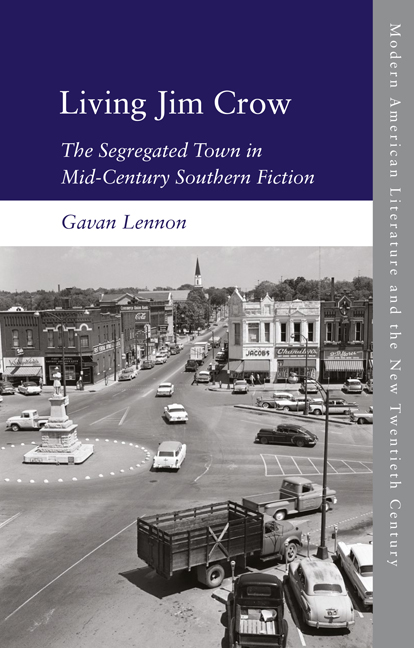Book contents
- Frontmatter
- Contents
- Acknowledgements
- Introduction: Uncovering a Poetics of Protest
- 1 Creators of the Small Town: Anthropology, Racial Etiquette and African American Fiction in the 1930s
- 2 The White Town/Coloured Town Paradigm: Lillian Smith’s Maxwell
- 3 An Anatomy of Critique: Byron Herbert Reece’s Tilden
- 4 The Milan Cycle: Carson McCullers’s Milan
- 5 Breaking the Pencil: William Faulkner’s Jefferson
- 6 Knowing How to Curse: William Melvin Kelley’s Sutton
- Conclusion: (De)Generative Ground – The Field and the Segregated Town
- Notes
- Bibliography
- Index
Introduction: Uncovering a Poetics of Protest
Published online by Cambridge University Press: 15 October 2020
- Frontmatter
- Contents
- Acknowledgements
- Introduction: Uncovering a Poetics of Protest
- 1 Creators of the Small Town: Anthropology, Racial Etiquette and African American Fiction in the 1930s
- 2 The White Town/Coloured Town Paradigm: Lillian Smith’s Maxwell
- 3 An Anatomy of Critique: Byron Herbert Reece’s Tilden
- 4 The Milan Cycle: Carson McCullers’s Milan
- 5 Breaking the Pencil: William Faulkner’s Jefferson
- 6 Knowing How to Curse: William Melvin Kelley’s Sutton
- Conclusion: (De)Generative Ground – The Field and the Segregated Town
- Notes
- Bibliography
- Index
Summary
Immediately following the opening credits of Frank Capra's 1946 film It's a Wonderful Life, a close-up shot of a street sign informs the imagined viewer ‘You are Now in Bedford Falls’. The sign is a visual symbol of inclusion in an archetypal small American town. A montage of Bedford Falls’ institutions follows this shot, including a pharmacy, a bank and a boarding house, while the voice of each proprietor is heard petitioning God for mercy for George Bailey, played by James Stewart. In these images, Capra presents a typology of the American town, suggesting that Bedford Falls (and, later, its perverse mirror image, Pottersville) is socially integral and economically effective because the community and its infrastructure of buildings and services operate seamlessly.
The litany of the town's offices that Capra presents suggests a model for reading cultural representations of the American town. It's a Wonderful Life depicts a supposedly typical American town in the immediate post-war period as the site of personal difficulties (the plot's catalyst is Bailey's decision to commit suicide) that can be overcome through the successful cooperation of each of the town's inhabitants and the spaces they occupy personally and professionally. Racial segregation remains just out of view in Capra's film. Bailey's peregrinations through Bedford Falls and Pottersville bring him to working-class and immigrant neighbourhoods but never to the section of town where, presumably, Bailey's African American housekeeper Annie lives. While this mid-century American town is not innocent of racism or racial segregation, its creators can turn away from racism as a structuring principle in small-town space and society. In cultural representations of the United States South from the 1940s to the early 1960s, racial segregation is not only a foundational component of the typical town but also the central prism through which artists enact social critique. In amplifying the role of the town as both setting and mode of critique, Living Jim Crow: The Segregated Town in Mid-Century Southern Fiction models a critical practice for recognising and articulating the role of aesthetics in racial protest.
In this book, I identify and outline a typology of the fictional southern town specific to mid-century writing emerging from and concerned with the US South. The typology I reveal is different from Capra's American archetype because it is governed by the legal and structural frameworks of de jure racial segregation.
- Type
- Chapter
- Information
- Living Jim CrowThe Segregated Town in Mid-Century Southern Fiction, pp. 1 - 20Publisher: Edinburgh University PressPrint publication year: 2020



